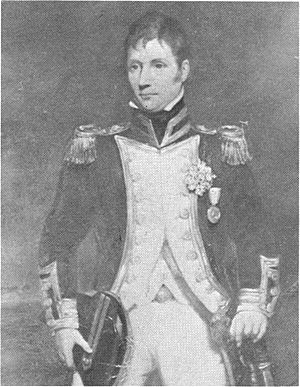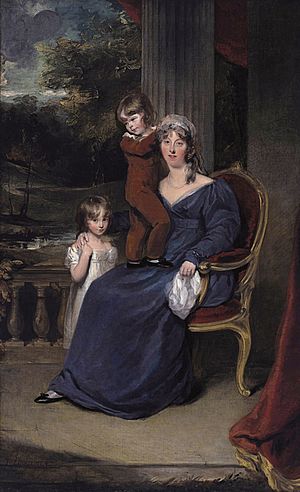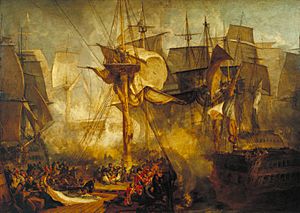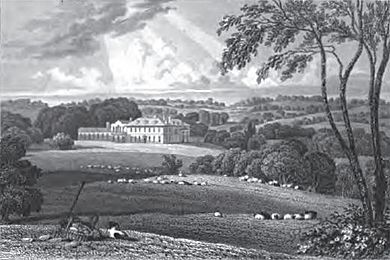Eliab Harvey facts for kids
Quick facts for kids
Sir Eliab Harvey
|
|
|---|---|

Sir Eliab Harvey
|
|
| Born | 5 December 1758 Rolls Park, Chigwell, Essex |
| Died | 20 February 1830 (aged 71) Rolls Park, Chigwell, Essex |
| Allegiance | United Kingdom |
| Service/ |
Royal Navy |
| Years of service | 1771–1810 |
| Rank | Admiral |
| Battles/wars | American Revolutionary War French Revolutionary Wars • Capture of Guadeloupe & Martinique Napoleonic Wars • Battle of Trafalgar |
| Awards | Knight Grand Cross of the Order of the Bath |
| Other work | Member of Parliament for Maldon (1780–1784) and Essex (1802–1812), (1820–1830) |
Admiral Sir Eliab Harvey (5 December 1758 – 20 February 1830) was a brave and strong-willed officer in the Royal Navy. He served during the French Revolutionary and Napoleonic Wars. Harvey was known for his military skills, especially at the famous Battle of Trafalgar.
At Trafalgar, he commanded HMS Temeraire. His ship played a key role in making two French warships surrender. Later, he even created his family motto from the names of these ships: "Redoutable et Fougueux". Outside the Navy, Harvey was also a Member of Parliament for Maldon and Essex. He was also knighted. His career ended early after a disagreement with another admiral.
Contents
Who Was Eliab Harvey?
Eliab Harvey was born in Chigwell, Essex. His father, William Harvey, was also a Member of Parliament. Sadly, his father died when Eliab was only five years old. Eliab was named after his great-grandfather, who was the brother of the famous William Harvey. This William Harvey discovered how blood circulates in the body.
Young Eliab grew up at his family home, Rolls Park, in Chigwell. He went to Westminster School and then Harrow School. When he was 13, in 1771, his name was put on the books of a naval ship, HMS Mary. This was a common practice back then. It helped young officers gain experience and get promoted faster, even if they weren't actually on the ship.
During his school holidays, Harvey did serve at sea. He joined HMS Orpheus in 1773.
In May 1774, Harvey officially joined the Navy as a midshipman. He served on the sloop HMS Lynx in the West Indies for two years. When the American Revolutionary War began, he returned to Britain.
Later, he went back to North America on HMS Mermaid. He then moved to the main ship of the North America fleet, HMS Eagle. In 1778, his ship, HMS Liverpool, was wrecked near Long Island. After this, he rejoined Eagle and returned to Britain. He was promoted to lieutenant in February 1779.
Time in Politics and Promotions
After his promotion, Harvey took a break from the Navy for three years. He became a Member of Parliament for Maldon in 1780. He held this seat for four years. In 1781, he briefly commanded HMS Dolphin.
He returned to the Navy in 1782 and was promoted to commander. Soon after, in 1783, he became a Post Captain.

When peace was made in 1783, Harvey took another break from the Navy. He continued his work as a Member of Parliament. When his older brother died in 1779, Harvey inherited a lot of money. He was known for spending large amounts of money.
Despite his lifestyle, Harvey married Lady Louisa Nugent in 1784. Louisa was the daughter of a wealthy man, Robert Nugent, 1st Earl Nugent. They had nine children together. Six of their daughters outlived their father. Sadly, Harvey's oldest son died fighting in the British Army in 1812. Harvey spent his time between London and his family home, Rolls Park.
In 1790, Harvey was called back to the Navy for six months. Three years later, he was called back again when the French Revolutionary Wars began. He stayed in service for the next 16 years, with only a short break in 1802.
Fighting in the West Indies
In 1793, Harvey became captain of HMS Santa Margarita in the West Indies. There, he helped capture the French colonies of Guadeloupe and Martinique. In 1794, he returned to Britain. He then served in a squadron that successfully raided the French coast.
In 1795, Harvey took command of the large warship HMS Valiant. He served in the Channel Fleet and later in the West Indies. In 1797, he returned to Britain due to illness. He then commanded the Essex sea defenses.
In 1800, Harvey went back to sea on HMS Triumph. He stayed on this ship until 1802. During this time, he also became a Member of Parliament for Essex. Even after returning to the Navy in 1803 as captain of HMS Temeraire, he remained in Parliament until 1812.
The Battle of Trafalgar
When the war with France started again, Temeraire was part of the Channel Fleet. They blocked French ports until 1805. Then, Harvey was sent to join Horatio Nelson's fleet off Cadiz.
On October 21, 1805, the Battle of Trafalgar began. Harvey's Temeraire was the second ship in Nelson's group. Temeraire was faster than Nelson's flagship, HMS Victory. So, Temeraire started to pull ahead. Nelson had to tell Captain Harvey to stay in his proper place behind Victory.
Harvey's Role in the Battle
During the battle, Harvey's ship was heavily involved. Temeraire fired powerful shots into the French ship Redoutable. This badly damaged the French ship and forced it to surrender. Redoutable then got tangled with Victory and Temeraire.
The three ships then drifted into another French ship, Fougueux. British fire disabled Fougueux. A boarding party from Temeraire then forced Fougueux's crew to surrender. Harvey later used this event for his personal motto: "Redoutable et Fougueux".
After the battle, Harvey was praised for his bravery. Admiral Cuthbert Collingwood mentioned him specially in his report. Because of this, Harvey was promoted to rear-admiral in November 1805. He was also one of the people who carried Nelson's coffin at his funeral.
Later Life and Retirement
After Trafalgar, Harvey was given command of the ship HMS Tonnant. He served under Lord Gambier. Harvey was upset when he wasn't given command of the British ships at the Battle of Basque Roads. He strongly expressed his anger to Gambier. As a result, he was removed from Gambier's council.
Harvey resigned from the Navy in May 1809 because of this disagreement. He returned to the Navy a year later, in March 1810. However, he was never called to active service again. Despite this, he continued to receive promotions due to his seniority. He became a vice-admiral in 1810 and a full admiral in 1819.
He was also made a Knight Commander of the Order of the Bath in 1815 and a Knight Grand Cross in 1825. Harvey spent more time in politics during his retirement. He returned to his seat as a Member of Parliament for Essex from 1820 to 1830.
Eliab Harvey passed away in 1830 at his family home, Rolls Park. He was buried in the Harvey family crypt at St Andrew's Church in Hempstead, Essex. The crypt holds the remains of many family members, including his famous ancestor's brother, Dr. William Harvey. A memorial to him is also in the church.
The Harvey Grammar School in Folkestone uses Harvey's motto and his ship's name, 'Temeraire', on its crest. Eliab Harvey himself designed this crest.
Images for kids




